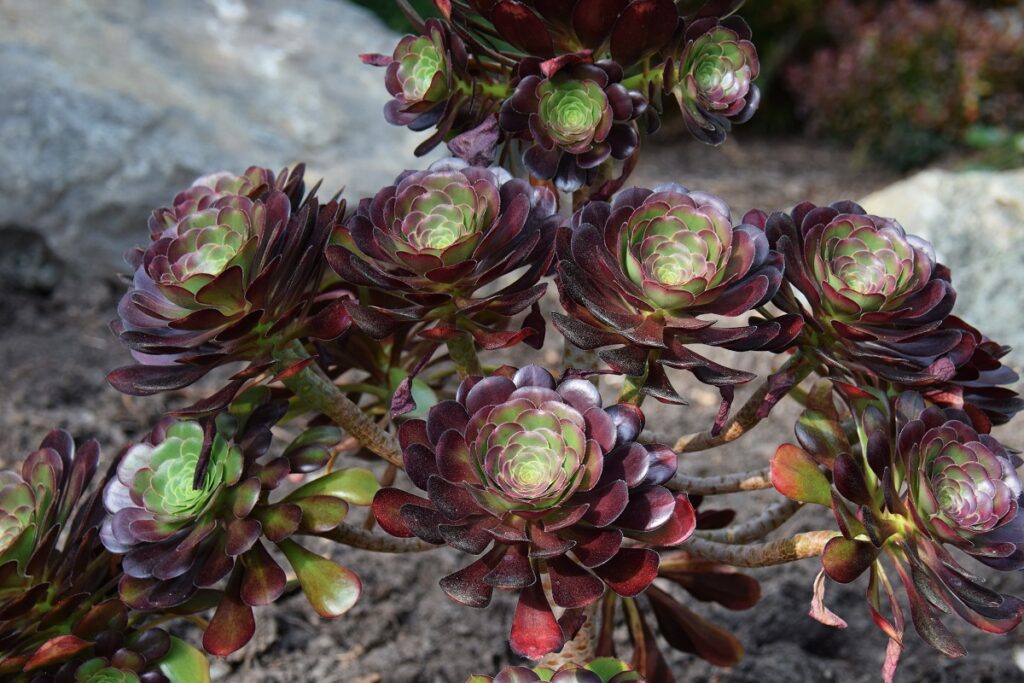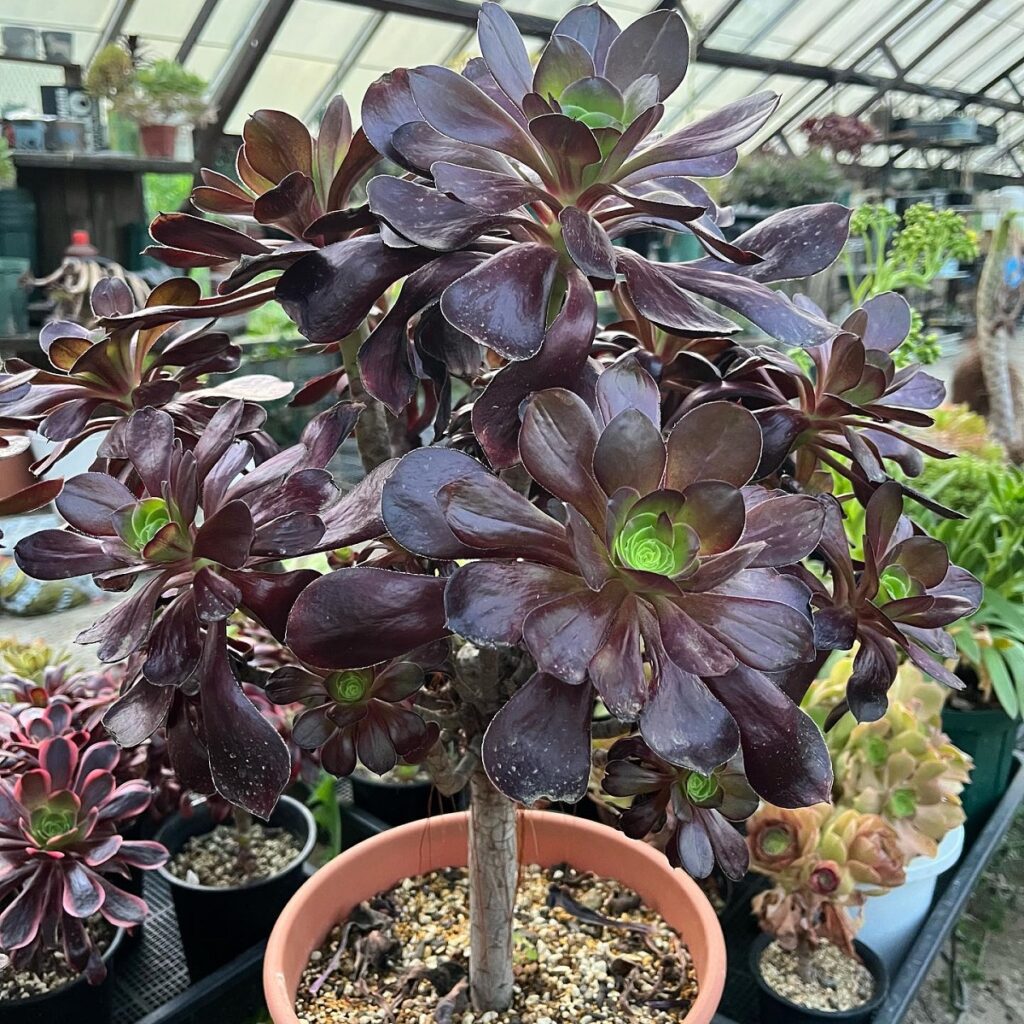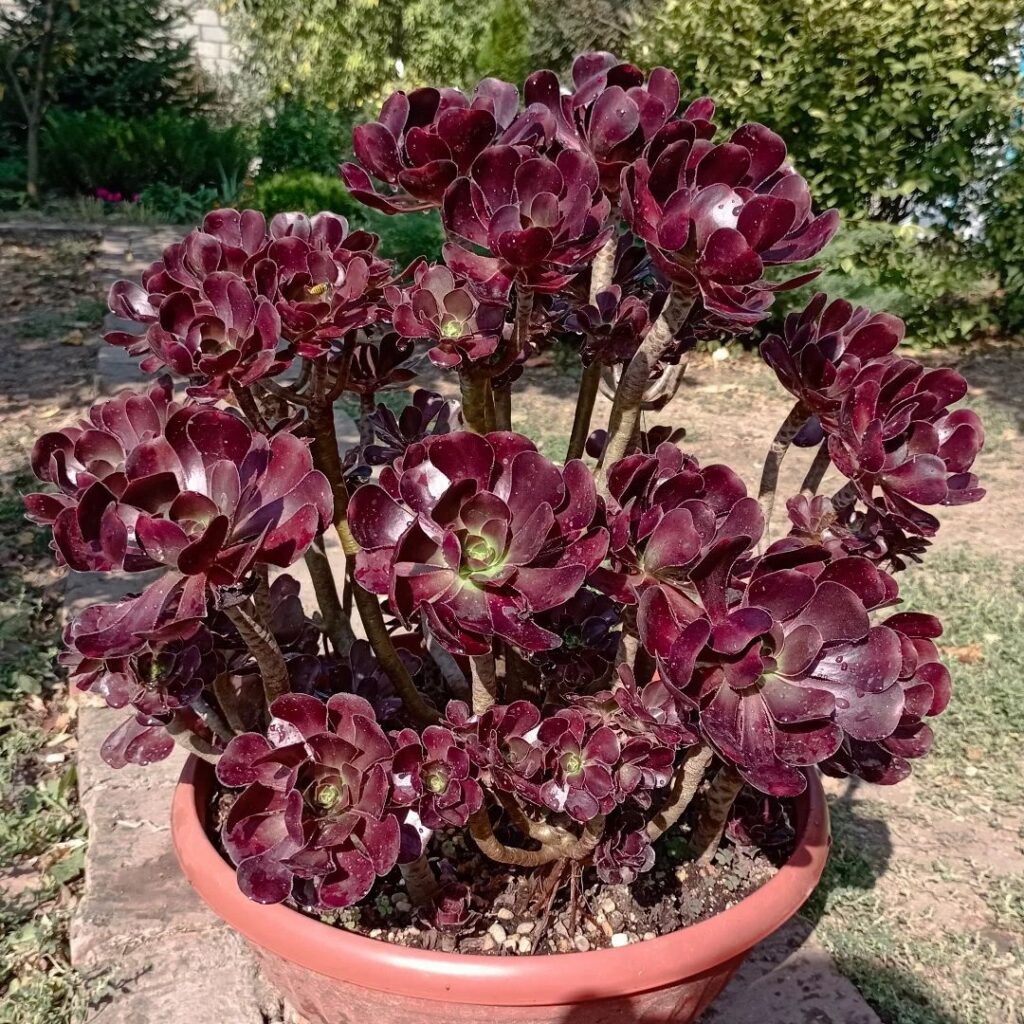The Cyclops Aeonium Hybrid: A Bold Blend of Succulent Superstars
Imagine a plant so striking, so mesmerizing, that it instantly captivates your senses. Enter the Cyclops Aeonium, a succulent sensation that’s about to rock your gardening world! This bold beauty is the result of a celestial union between two succulent superstars – Aeonium undulatum and the ever-popular Aeonium arboreum ‘Zwartkop’. Prepare to be dazzled by its larger-than-life rosettes, measuring up to 18 inches across, adorned with glossy, fleshy, dark reddish-bronze leaves that flaunt a vibrant green heart. Talk about a showstopper!
But wait, there’s more! When this cyclops decides to bloom, brace yourself for a spectacle like no other. Imagine bright golden racemes bursting forth, each one a miniature star-shaped flower that will leave you utterly enchanted. It’s like having your own personal fireworks display right in your garden or home!

Contents
About Cyclops Aeonium
This magnificent hybrid isn’t just a pretty face – it’s a true succulent powerhouse! Imagine a shrub-like plant that can reach towering heights of up to 5 feet tall and spread out to an impressive 4 feet wide when grown in ideal conditions. And let’s not forget its rugged nature – the Cyclops Aeonium can thrive in sandy, dry to moderately moist, well-drained soils and even handle poor soil conditions like a champ.
While it basks in the glory of full sun, this adaptable beauty can also tolerate some light shade. And here’s the real kicker – despite its drought-tolerant superpowers, the Cyclops Aeonium requires more frequent watering than its succulent siblings due to its relatively small, shallow root system. But fear not, for we’ll guide you through the art of keeping this beauty perfectly hydrated.
Related Post:
58 Aeonium Varieties With Pictures
How To Care For Cyclops Aeonium
Light
The Cyclops Aeonium craves bright, direct sunlight all year round, whether you’re growing it indoors or out. If you’re keeping it as a houseplant, a sunny south-facing window is the prime real estate. But if the light conditions aren’t up to par, don’t be surprised if your cyclops starts throwing a tantrum with deformed, elongated leaves and eventual death. A grow light can be a lifesaver in low-light situations – just make sure to position it close enough to mimic those glorious sun rays.
Water
Here’s the golden rule for watering your Cyclops Aeonium: moderation is key! These roots need to stay slightly moist, but not waterlogged. Before you reach for the watering can, do the good ol’ knuckle test – if the top 1-2 inches of soil are dry, it’s time for a drink. During the growing season, aim for a watering frequency of every 1-2 weeks, but in the winter months (October to February), your cyclops will be perfectly content with just enough hydration to prevent the soil from completely drying out.
Remember, these succulents despise soggy feet, so make sure any excess water can drain freely or be poured out after watering. And while good old H2O from the tap is perfectly fine, your cyclops will absolutely love it if you treat it to some fresh rainwater every now and then.
Soil

For your Cyclops Aeonium to truly thrive, you’ll need to create the perfect soil mix. Aim for a nutrient-poor blend that’s well-draining and airy. A great recipe is 60% succulent or cactus soil mixed with 40% mineral components like gravel, perlite, lava rocks, and a sprinkle of quartz sand. These mineral buddies will ensure proper airflow and moisture retention while allowing excess water to flow right through.
Fertilizer
The Cyclops Aeonium benefits from a light feed during its growing season. Use a balanced, succulent-specific fertilizer and dilute it to half strength. Apply every 4-6 weeks from spring through summer for lush, vibrant growth.
Temperature and Humidity
Your Cyclops Aeonium is a warm-weather lover, thriving in temperatures between 65°F and 73°F (18°C to 23°C). During the winter months, it prefers a cooler range around 54°F (12°C) and as much direct sunlight as possible. Just keep in mind that temperatures below 50°F (10°C) are a big no-no for this tropical beauty.
As for humidity, your cyclops isn’t too fussy – average household humidity levels are perfectly fine. But if you live in an arid region, an occasional misting can help keep those luscious leaves looking their best.
Pests and Problems
One of the best things about the Cyclops Aeonium is its virtually pest and disease-free nature. It’s like having a superhero plant that can fend off any villains that come its way! However, if you do notice any unwanted critters or issues, don’t panic – a gentle blast of water or an organic insecticidal soap should do the trick.
Pruning
While the Cyclops Aeonium doesn’t require extensive pruning, you may want to give it a little grooming every now and then to maintain its shape and remove any dead or damaged leaves or stems. Just remember, each rosette only blooms once in its lifetime (a process known as being monocarpic), so don’t go snipping off those gorgeous golden racemes until they’ve had their moment in the sun.
Potting and Repotting
If you’re growing your Cyclops Aeonium in a container, choose a well-draining pot with ample room for its roots to spread out. And when it comes to repotting, wait until you see those roots peeking out from the drainage holes or the plant starts looking a bit too cozy in its current home. Gently remove the plant from its pot, prune away any damaged roots, and replant it in a slightly larger container with fresh succulent soil.
How to Propagate Cyclops Aeonium

Ready to multiply your Cyclops Aeonium collection? Propagation is a breeze with this beauty! Here’s how you can grow new plants from cuttings or leaves:
Cuttings:
- At the start of the growing season, snip off 3-4 inch stem cuttings
- Allow the cuttings to dry for 2-3 days
- Plant the cuttings in moistened succulent soil
- For faster rooting, you can dip the cuttings in rooting hormone (optional)
- Place the newly planted cuttings in a bright, indirect light spot
- Water sparingly, just enough to keep the soil slightly moist
- After 3-4 weeks, roots should start forming
- Once rooted, move the new plants to a sunnier location and care for them like mature specimens
Leaf Cuttings:
- Gently pluck or cut a single leaf from the rosette, ensuring you get as much of the base as possible
- Allow the leaf to dry for a day or two
- Place the leaf on top of a well-draining succulent soil mix
- Lightly mist the soil to keep it slightly moist
- In a few weeks, you should see tiny plantlets emerging from the leaf
- Once the new plants are about an inch tall, you can transplant them into their own pots
With a little love and care, your Cyclops Aeonium will reward you with years of jaw-dropping beauty and succulent splendor. So, what are you waiting for? Bring home this bold blend of succulent superstars and let the gardening adventures begin!
